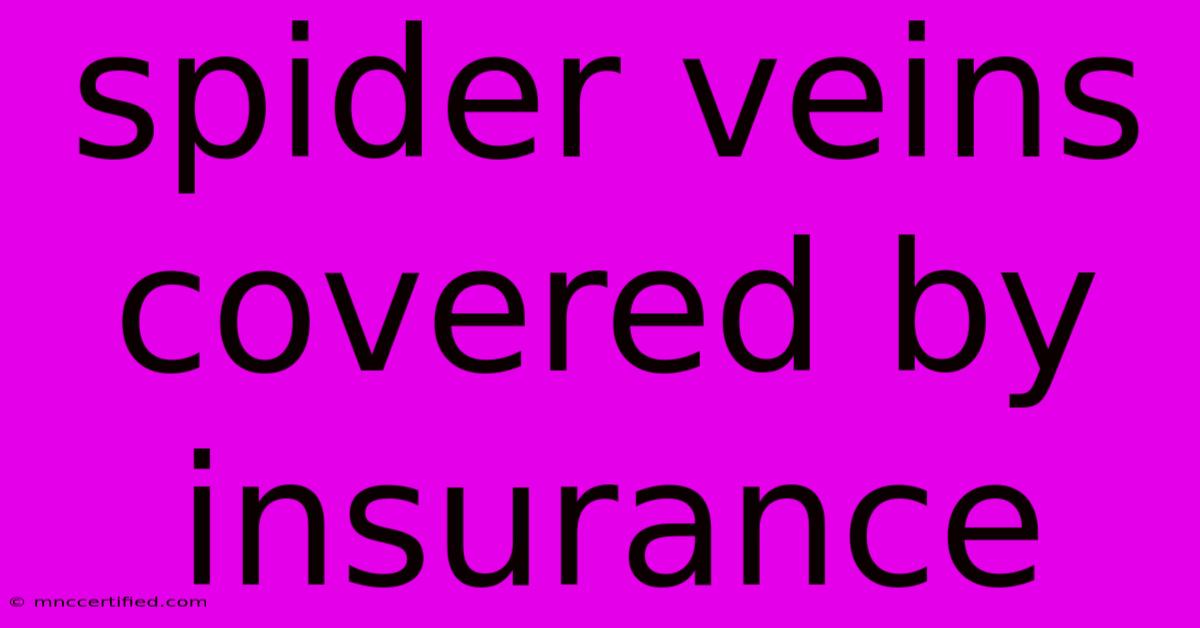Spider Veins Covered By Insurance

Table of Contents
Spider Veins Covered by Insurance: A Comprehensive Guide
Spider veins, those unsightly, web-like blood vessels near the skin's surface, can be more than just a cosmetic concern. While often perceived as purely aesthetic, they can sometimes indicate underlying health issues and, in certain cases, insurance may cover treatment. This guide will delve into the complexities of insurance coverage for spider vein removal, helping you understand what to expect and how to maximize your chances of approval.
Understanding Insurance Coverage for Medical Procedures
Before we dive into the specifics of spider vein treatment, it's crucial to understand the general principles of insurance coverage. Most insurance plans prioritize medically necessary procedures over purely cosmetic ones. This means that the likelihood of insurance covering spider vein treatment hinges on whether the condition is deemed medically necessary.
What Makes Spider Vein Treatment Medically Necessary?
The key factor determining medical necessity is the presence of associated symptoms. Simple cosmetic concerns are unlikely to be covered. However, if your spider veins are accompanied by:
- Pain: Significant aching or discomfort in the affected area.
- Swelling: Noticeable swelling in the legs or ankles.
- Leg cramps: Frequent and painful leg cramps.
- Heavy, aching legs: Persistent feelings of heaviness or aching in the legs.
- Ulcers or skin discoloration: Open sores or changes in skin pigmentation near the spider veins.
These symptoms suggest a more serious underlying condition, such as chronic venous insufficiency (CVI), which significantly increases the chances of your insurance provider covering treatment.
Types of Spider Vein Treatment and Insurance Coverage
Several treatments are available for spider veins, each with varying levels of invasiveness and associated costs. Insurance coverage often depends on the specific treatment method and your individual plan.
Common Spider Vein Treatments:
- Sclerotherapy: Involves injecting a solution into the veins to close them. This is often a covered treatment if medically necessary due to associated symptoms.
- Laser Therapy: Uses laser energy to destroy the spider veins. Coverage is less common than sclerotherapy, and approval depends heavily on the presence of medical necessity.
- Endovenous Ablation: A minimally invasive procedure for larger varicose veins, often covered if they are causing significant symptoms. While not directly for spider veins, it can address the underlying venous insufficiency.
How to Increase Your Chances of Insurance Coverage
To maximize your chances of insurance coverage for spider vein treatment, follow these steps:
- Consult Your Physician: A thorough medical evaluation is essential. Your doctor will assess your condition, document any symptoms, and determine if the treatment is medically necessary. Detailed medical documentation is crucial for insurance claims.
- Pre-Authorization: Contact your insurance provider before scheduling any treatment. Obtain pre-authorization for the specific procedure, detailing the medical necessity based on your symptoms. This can save you from significant out-of-pocket expenses.
- Understand Your Policy: Review your insurance policy carefully. Look for specific exclusions or limitations regarding cosmetic procedures. Understanding your plan's coverage for venous disorders is vital.
- Appeal Denied Claims: If your initial claim is denied, don't give up. Gather all relevant medical documentation, including photos of your spider veins and a detailed explanation from your doctor, and file an appeal.
The Bottom Line: Insurance and Spider Vein Treatment
While insurance coverage for spider vein removal isn't guaranteed, it's definitely possible, particularly if the veins are causing significant medical issues. Focus on documenting any associated symptoms, seeking a physician's evaluation, and obtaining pre-authorization to increase your chances of successful insurance coverage. Remember, proactive communication with your physician and insurance provider is key. This comprehensive approach will significantly improve your chances of getting the treatment you need without breaking the bank.

Thank you for visiting our website wich cover about Spider Veins Covered By Insurance. We hope the information provided has been useful to you. Feel free to contact us if you have any questions or need further assistance. See you next time and dont miss to bookmark.
Featured Posts
-
Trump Dance Trend In American Sports
Nov 19, 2024
-
Animal Assisted Therapy Insurance
Nov 19, 2024
-
Acceptance Insurance Lake City Fl
Nov 19, 2024
-
Insurance Companies In Kinston Nc
Nov 19, 2024
-
Supermicro Stock Rallies Avoiding Delisting
Nov 19, 2024